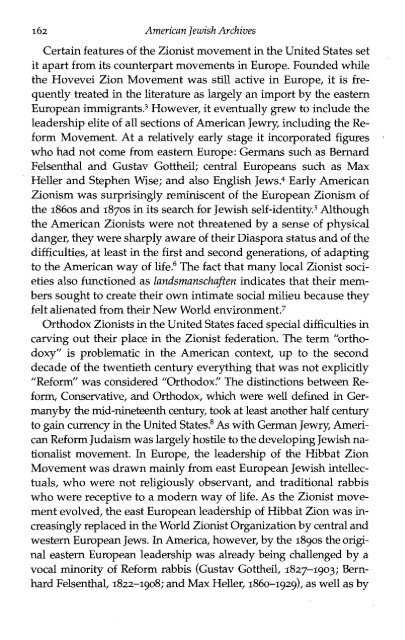Create successful ePaper yourself
Turn your PDF publications into a flip-book with our unique Google optimized e-Paper software.
162 <strong>American</strong> <strong>Jewish</strong> <strong>Archives</strong><br />
Certain features of the Zionist movement in the United States set<br />
it apart from its counterpart movements in Europe. Founded while<br />
the Hovevei Zion Movement was still active in Europe, it is fre-<br />
quently treated in the literature as largely an import by the eastern<br />
European immigrants.3 However, it eventually grew to include the<br />
leadership elite of all sections of <strong>American</strong> Jewry, including the Re-<br />
form Movement. At a relatively early stage it incorporated figures<br />
who had not come from eastern Europe: Germans such as Bernard<br />
Felsenthal and Gustav Gottheil; central Europeans such as Max<br />
Heller and Stephen Wise; and also English Jews.+ Early <strong>American</strong><br />
Zionism was surprisingly reminiscent of the European Zionism of<br />
the 1860s and 1870s in its search for <strong>Jewish</strong> self-identity.5 Although<br />
the <strong>American</strong> Zionists were not threatened by a sense of physical<br />
danger, they were sharply aware of their Diaspora status and of the<br />
difficulties, at least in the first and second generations, of adapting<br />
to the <strong>American</strong> way of life! The fact that many local Zionist soci-<br />
eties also functioned as landsmanschaften indicates that their mem-<br />
bers sought to create their own intimate social milieu because they<br />
felt alienated from their New World environment.7<br />
Orthodox Zionists in the United States faced special difficulties in<br />
carving out their place in the Zionist federation. The term "ortho-<br />
doxy" is problematic in the <strong>American</strong> context, up to the second<br />
decade of the twentieth century everything that was not explicitly<br />
"Reform" was considered "Orthodox." The distinctions between Re-<br />
form, Conservative, and Orthodox, which were well defined in Ger-<br />
manyby the mid-nineteenth century, took at least another half century<br />
to gain currency in the United States? As with German Jewry, Ameri-<br />
can Reform Judaism was largely hostile to the developing <strong>Jewish</strong> na-<br />
tionalist movement. In Europe, the leadership of the Hibbat Zion<br />
Movement was drawn mainly from east European <strong>Jewish</strong> intellec-<br />
tuals, who were not religiously observant, and traditional rabbis<br />
who were receptive to a modern way of life. As the Zionist move-<br />
ment evolved, the east European leadership of Hibbat Zion was in-<br />
creasingly replaced in the World Zionist Organization by central and<br />
western European Jews. In America, however, by the 1890s the origi-<br />
nal eastern European leadership was already being challenged by a<br />
vocal minority of Reform rabbis (Gustav Gottheil, 1827-1903; Bern-<br />
hard Felsenthal, 1822-1908; and Max Heller, 1860-1929), as well as by

















